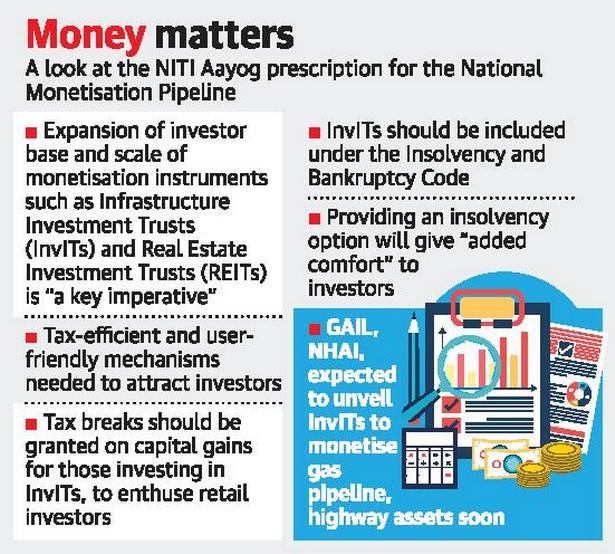
Critical Elements of National Monetisation Pipeline | 30 Aug 2021
Why in News

Key Points
- About NMP:
- The NMP estimates aggregate monetisation potential of Rs 6 lakh crores through core assets of the Central Government, over a four-year period, from FY 2022 to FY 2025.
- The plan is in line with Prime Minister's strategic divestment policy, under which the government will retain presence in only a few identified areas with the rest tapping the private sector.
- Under it, the government plans to use the InvITs and REITs route to monetise public assets like highways, gas pipelines, railway tracks and power transmission lines.
- Highlights of the NITI Aayog Recommendations:
- Bringing InvITs Under Insolvency and Bankruptcy Code (IBC): While InvITs structures have been used in India since 2014, such Trusts are not considered a 'legal person'.
- Therefore, the IBC regulations are not applicable for InvIT loans. The lenders do not have an existing process for recourse to project assets.
- Thus, extending IBC provisions to InvITs would help lenders access a faster and more effective debt restructuring and resolution option.
- Tax Breaks: Tax-efficient and user-friendly mechanisms like allowing tax benefits in InvITs as eligible security to invest under Section 54EC of the Income-Tax Act, 1961, would attract retail investors (individual/non-professional investors).
- Though this will entail a cost in the form of loss of revenue for the exchequer, the long-term benefits may outweigh the cost as linking investments in specified bonds with the capital gains exemption had proved to be a success in the past.
- Section 54EC of the Income-Tax Act, 1961, allows taxpayers to offset long-term capital gains from transactions in immovable properties through investments in bonds issued by some government-backed infrastructure firms.
- This applies to bonds issued by the National Highway Authority of India, Rural Electrification Corporation, Power Finance Corporation and the Indian Railway Finance Corporation.
- About Infrastructure Investment Trusts:
- They are instruments that work like mutual funds.
- They are designed to pool small sums of money from a number of investors to invest in assets that give cash flow over a period of time. Part of this cash flow would be distributed as a dividend back to investors.
- The minimum investment amount in an InvIT Initial Public Offering (IPO) is
Rs 1 lakh, therefore, InvITs are suitable for high networth individuals, institutional and non-institutional investors.
- InvITs are listed on exchanges just like stocks — through IPOs.
- InvITs are regulated by the Securities and Exchange Board of India (SEBI) (Infrastructure Investment Trusts) Regulations, 2014.
- InvITs are structured so as to give investors an opportunity to invest in infrastructure assets with predictable cash flows, while the asset owners can raise upfront resources against future revenue cash flows from those assets, which in turn can be deployed in new assets or used to repay debt.
- About Real estate Investment Trust:
- ReITs are similar to InvITs, with a difference that these securities are linked to real estate.
- The structure of ReITs is similar to that of a mutual fund. However, unlike mutual funds, where the underlying asset is bonds, stocks and gold, ReITs invest in physical real estate.
- The money collected is deployed in income-generating real estate.
- This income gets distributed among the unit holders.
- Besides regular income from rents and leases, gains from capital appreciation of real estate also form an income for the unit holders.
- The minimum subscription limit for ReITs is Rs 50,000.
Way Forward
- Multi-stakeholder Approach: Infrastructure regulators and SEBI would need to work in tandem for a successful insolvency resolution of an InvITs which may involve a change in the sponsor, investment manager and/ or trustee or transfer of an infrastructure asset.
- Amendment in Income Tax Act: Industrial groups have proposed a separate section in the income tax law to provide capital gains tax relief for investments in eligible InvITs specifically holding NMP assets, which would be better than extending Section 54EC.
- Holistic Reforms: Streamlining operational modalities, encouraging investor participation and facilitating commercial efficiency’ could ensure ‘efficient and effective’ outcomes from the monetisation drive.
Source: TH

